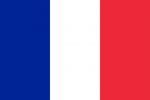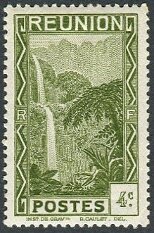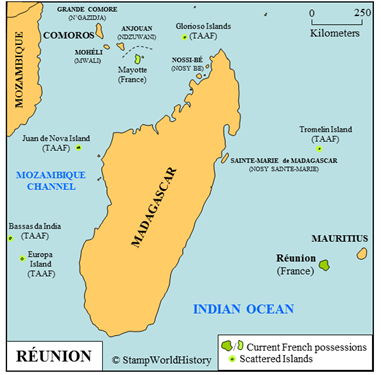
Réunion
Quick reference
General issues: French colony 1851, French colony 1885-1946, French overseas department 1946-1975
Country name on general issues: Réunion, France with overprint of the Réunion denomination ‘CFA’
Currency: 1 Franc = 100 Centimes 1851-1948, 1 (CFA) Franc = 100 Centimes 1948-1975
Population: 173 000 in 1900, 843 000 in 2015
Political history Réunion
Réunion is located in the Indian Ocean east of Madagascar. Réunion is an island of volcanic origin and was uninhabited before the arrival of the first Europeans. Réunion was discovered by the Portuguese in the early 16th century. The French claimed and settled on Réunion in the 17th century – Réunion becoming a French colony in the 18th century. The British shortly occupied Réunion during the Napoleonic Wars from 1810 to 1815. From its discovery in 1509, Réunion is known by a number of names given by the Portuguese[1]Ilha Mascarene and the French[2]Île Saint-Paul, Île Bourbon, Île Bonaparte . The French ultimately decided to call the island ‘Réunion’ in 1848.
Réunion long derived its main importance from being a port of call on the shipping routes to India and beyond – a position that was greatly reduced by the opening of the Suez Canal in 1869. The French, in the 18th century, introduced coffee as the main cash crop of the island. Coffee was to be replaced by sugar cane in the 19th century which, until the present day, is the most important crop on the island. The first settlers on Réunion having been French, the development of the coffee plantations brought people to Réunion from many different places – Africa, Madagascar, India and China. Many of these were slaves, until the abolition of slavery in 1848. The different population groups on the island have intermingled resulting in the current mixed population of Réunion.

Réunion
During WWII, the French administration on Réunion was loyal to the Vichy regime – the regime that collaborated with Nazi Germany – until taken over by the Free French under Charles De Gaulle in 1942. Just after WWII, as the French colonial empire was reorganized, Réunion became a French overseas department – a status equal to that of the departments of metropolitan France. In 2003, as France introduced an new administrative level just above that of the departments, Réunion, administratively, also became a French overseas region.
Being the first French possession in the region, other French possessions have been, at times, administered from Réunion – Sainte-Marie de Madagascar, Nossi-Bé and Mayotte – until the mid 19th century when Mayotte and later Madagascar became the center of administration for these possessions. After the independence of Madagascar in 1960, the Îles Éparses, or Scattered Islands, were administered from Réunion until attached in 2005 to the French Southern & Antarctic Lands – a French overseas territory called Terres Australes et Antarctiques Françaises shortened to TAAF in French.
Réunion currently derives most of its income from tourism and the production of cane sugar.
Postal history Réunion

1933 – The White Cascade, best visible from the road to Salazie and, therefore, also called Cascade of Salazie.
The first stamps for Réunion are issued in 1851. Two stamps were issued: one for domestic use and one for the additional franking of international mail – both are in the very high catalog value category. From 1859 until 1885, the general issues for use in the French colonies were used. From 1885, stamps were again issued for Réunion. The first issues are overprints on the issues for the French colonies until, in 1892, the first definitives are issued – the common Navigation & Commerce design inscribed Réunion.
During WWII, stamps were prepared by the Vichy regime in France in 1941 and 1942. As these issues were never put on sale on Réunion, only mint items are listed. In 1943, issues reflect the take over of Réunion by the Free French with overprints and inscription reading ‘France Libre'[3]‘Free France’ . From 1949, stamps of metropolitan France are used – all overprinted with the Réunion denomination of the ‘CFA’ franc – a denomination widely used in the former French colonies. From 1975, the stamps of metropolitan France have been used without overprint.
Album pages
← Previous page: QuelimaneNext page: Rhodesia →



